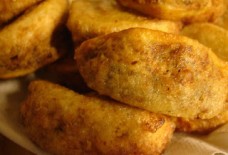Why do Moroccans Pour Their Tea So High?
By: Nouha Elyazidi / Arab America Contributing Writer
If you ever enter the home of a Moroccan, visit Morocco, or go to a Moroccan restaurant, chances are you will be served traditional Moroccan mint tea. This tea, called atay bil na3na3 in Arabic, is a staple in Moroccan culture. Moroccan mint tea is believed to have originated in the 12th century B.C! The tea has a dark-yellow or an almost coppery color, and the taste is strong yet refreshing. There are specific customs practiced when the tea is being presented to guests, such as the cups, teapot, and tray the tea is presented in. The height at which the tea is poured is also significant! Moroccans pride themselves on not only their delicious and flavorful tea but also their unique presentation of it. Let’s walk through the preparation and serving of Moroccan mint tea.
How is the tea prepared?
There are really only three main ingredients necessary for the preparation of Moroccan mint tea: gunpowder green tea, fresh mint leaves, and water. There are no real measurements for the ingredients, in fact, most Moroccan cuisine is prepared with very loose measurements. But for an estimate, it would be about one large spoonful of gunpowder green tea, around three cups of water, and approximately one handful of fresh mint leaves.
The water for the tea is boiled either on the stove or an electric kettle and while the water is boiling, a spoonful of gunpowder is added into a traditional Moroccan teapot called a berrad. Berrads are stainless steel teapots with a curved spout, a cone-shaped top, and typically feature a pattern or design on the bottom.
A small amount of the boiling water is placed into the berrad and then poured out, this is done to rinse the gunpowder tea. The berrad is filled with boiling water and the fresh mint leaves are then added. The berrad is then placed on the stove on very low heat for just a few minutes to allow the flavors of the gunpowder green tea and mint to release into the water. The tea is now ready to be served! Most hosts serving the tea will provide honey or sugar on the side so guests can adjust the level of sweetness to their liking.
How is the tea served?
The tea is poured from the berrad into traditional Moroccan teacups. Moroccan teacups come in a range of beautiful colors and designs, from bold colors to elegant designs in silver and gold. If tea is being brought out to guests, it is presented in a large tray called a sayniya, usually also made of stainless steel. Many Moroccan buy teacups, berrads, and trays with matching or similar designs, again for presentation purposes.
If you watch someone pour the tea, you will notice that they make an effort to pour their tea from as high as they can without spilling it. The cultural significance behind this is that the higher the tea is poured, the more welcome your guests are. In addition, pouring the tea from a high distance creates little white foam bubbles that rest on top of the tea, and the idea is the more bubbles on top of the cup, the nicer the tea will look. Professionals at tea pouring have mastered the art and can pour from impressively high distances.
Moroccan mint is never served alone. Many hosts will bring out dates, nuts, traditional Moroccan cookies, cakes, or other sweets. If dates are served they are usually stuffed with either nuts or marzipan and can be decorated with crushed pistachios, dried rose petals, sugar, chocolate, coconut shavings, and more. Moroccans have countless scrumptious cookies, most are made from a nut base.
Moroccan mint tea has a great cultural significance and the attention to detail that goes into its presentation is truly fascinating. The video below demonstrates the steps in making the tea, it is definitely worth trying. And as we say in Morocco, bsaha!
Check out Arab America’s blog here!








